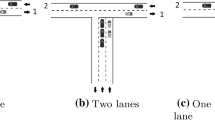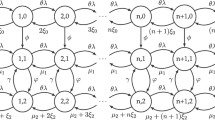Abstract
For dynamic scheduling of multi-class systems where backorder cost is incurred per unit backordered regardless of the time needed to satisfy backordered demand, the following models are considered: the cost model to minimize the sum of expected average inventory holding and backorder costs and the service model to minimize expected average inventory holding cost under an aggregate fill rate constraint. Use of aggregate fill rate constraint in the service model instead of an individual fill rate constraint for each class is justified by deriving equivalence relations between the considered cost and service models. Based on the numerical investigation that the optimal policy for the cost model is a base-stock policy with switching curves and fixed base-stock levels, an alternative service model is considered over the class of base-stock controlled dynamic scheduling policies to minimize the total inventory (base-stock) investment under an aggregate fill rate constraint. The policy that solves this alternative model is proposed as an approximation of the optimal policy of the original cost and the equivalent service models. Very accurate heuristics are devised to approximate the proposed policy for given base-stock levels. Comparison with base-stock controlled First Come First Served (FCFS) and Longest Queue (LQ) policies and an extension of LQ policy (Δ policy) shows that the proposed policy performs much better to solve the service models under consideration, especially when the traffic intensity is high.
Similar content being viewed by others
References
Bertsekas, D. P. (2001). Dynamic programming and optimal control (Vol. 2). Belmont: Athena Scientific.
Bertsimas, D., & Paschalidis, I. Ch. (2001). Probabilistic service level guarantees in make-to-stock manufacturing systems. Operations Research, 49, 119–133.
Bollapragada, R., Uday, S. R., & Zhang, J. (2004a). Managing two-stage serial inventory systems under demand and supply uncertainty and customer service level requirements. IIE Transactions, 36, 73–85.
Bollapragada, R., Uday, S. R., & Zhang, J. (2004b). Managing inventory and supply performance in Assembly Systems with random supply, capacity and demand. Management Science, 50(12), 1729–1743.
Boyacı, G., & Gallego, G. (2001). Serial production/distribution systems under service constraints. Manufacturing and Service Operations Management, 3, 43–50.
Buzacott, J. A., & Shanthikumar, J. G. (1993). Stochastic models of manufacturing systems. New York: Prentice Hall.
de Vericourt, F., Karaesmen, F., & Dallery, Y. (2000). Dynamic scheduling in a make-to-stock system: a partial characterization of optimal policies. Operations Research, 48, 811–819.
Glasserman, P. (1996). Allocating production capacity among multiple products. Operations Research, 44, 724–734.
Ha, A. (1997). Optimal dynamic scheduling policy for a make-to-stock production system. Operations Research, 45, 42–53.
Kat, B. (2005). On the service models for dynamic scheduling of multi-class base-stock controlled systems. M.Sc. Thesis, Ankara, Turkey: Middle East Technical University.
Kat, B., & Avṣar, Z. M. (2008). Service models with aggregate fill rate constraint for dynamic scheduling of multi-class systems (Technical Report No: 08-11). Ankara, Turkey: Industrial Engineering Department, Middle East Technical University.
Peña-Perez, A., & Zipkin, P. (1997). Dynamic scheduling rules for a multiproduct make-to-stock queue. Operations Research, 45, 919–930.
Rosling, K. (2002). Inventory cost rate functions with nonlinear shortage costs. Operations Research, 50(6), 1007–1017.
Shang, K. H., & Song, J. S. (2004). Analysis of serial supply systems with a service constraint (Working Paper). Duke University, The Fuqua School of Business.
Sleptchenko, A., van der Heijden, M., & van Harten, A. (2005a). Using repair priorities to reduce stock investment in spare part networks. European Journal of Operational Research, 163, 733–750.
Sleptchenko, A., Adan, I. J. B. F., & van Houtum, G. J. (2005b). Optimal static repair priorities in spare parts supply systems (Working paper). Eindhoven University of Technology, Department of Technology Management.
Tijms, H. C. (1994). Stochastic models: An algorithmic approach. New York: Wiley.
van Houtum, G. J., Adan, I. J. B. F., & van der Wal, J. (1997). The symmetric longest queue system. Communications in Statistics: Stochastic Models, 13, 105–120.
van Houtum, G. J., & Zijm, W. H. M. (2000). On the relations between cost and service models for general inventory systems. Statistica Neerlandica, 54, 127–147.
Veatch, M., & Wein, L. M. (1996). Scheduling a make-to-stock queue: Index policies and hedging points. Operations Research, 44, 634–647.
Wein, L. M. (1992). Dynamic scheduling of a multi-class make-to-stock queue. Operations Research, 40, 724–735.
Zheng, Y., & Zipkin, P. (1990). A queueing model to analyze the value of centralized inventory information. Operations Research, 38, 296–307.
Zipkin, P. (1995). Performance analysis of a multi-item production-inventory system under alternative policies. Management Science, 41, 690–703.
Zipkin, P. (2000). Foundations of inventory management. New York: McGraw-Hill.
Author information
Authors and Affiliations
Corresponding author
Rights and permissions
About this article
Cite this article
Kat, B., Avṣar, Z.M. Using aggregate fill rate for dynamic scheduling of multi-class systems. Ann Oper Res 182, 87–117 (2011). https://doi.org/10.1007/s10479-009-0535-2
Received:
Accepted:
Published:
Issue Date:
DOI: https://doi.org/10.1007/s10479-009-0535-2




